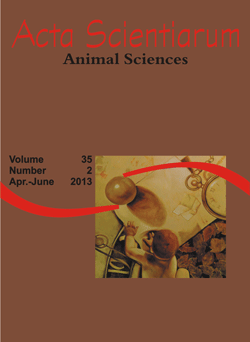<b>Thermoregulation of Girolando cows during summertime, in Pernambuco State, Brazil</b> - doi: 10.4025/actascianimsci.v35i2.16591
Keywords:
dairy cattle raising, heat stress, physiological parameters
Abstract
This work was carried out to evaluate the physiological thermoregulation responses of Girolando-breed dairy cows kept in feedlot during summertime. A total of 15 animals were used, belonging to three genetic groups: 1/2, 5/8 and 3/4 Holstein-Gir (HG), with five cows from each genetic group, distributed in a completely randomized design, in subplots. The physiological parameters were sweat rate (SR), respiratory rate (RR), epidermis temperature (ET) and coat surface temperature (CST), and were evaluated once a week, during nine weeks, from December 2009 to February 2010, totaling 135 observations. Throughout the experimental period, climatic data were recorded using an automated weather station, and later used to calculate the different thermal comfort indexes: THI (temperature-humidity index), BGHI (black globe temperature and humidity index) and RTL (radiant thermal load). 1/2 HG animals showed the highest SR and lowest RR, ET and CST of all three genetic groups, while 3/4 HG cows had the lowest mean SR and highest ET and CST. 5/8 HG cows had intermediate values for SR, ET and CST. Mean RR values did not differ between 5/8 and 3/4 HG cows. It was concluded that animals from genetic groups 3/4 and 5/8 HG showed greater sensibility to heat stress than 1/2 HG cows.
Downloads
Download data is not yet available.
Published
2012-12-03
How to Cite
Lima, I. de A., Azevedo, M. de, Borges, C. R. de A., Ferreira, M. de A., Guim, A., & Almeida, G. L. P. de. (2012). <b>Thermoregulation of Girolando cows during summertime, in Pernambuco State, Brazil</b> - doi: 10.4025/actascianimsci.v35i2.16591. Acta Scientiarum. Animal Sciences, 35(2), 193-199. https://doi.org/10.4025/actascianimsci.v35i2.16591
Issue
Section
Animal Production
DECLARATION OF ORIGINALITY AND COPYRIGHTS
- I Declare that current article is original and has not been submitted for publication, in part or in whole, to any other national or international journal.
The copyrights belong exclusively to the authors. Published content is licensed under Creative Commons Attribution 4.0 (CC BY 4.0) guidelines, which allows sharing (copy and distribution of the material in any medium or format) and adaptation (remix, transform, and build upon the material) for any purpose, even commercially, under the terms of attribution.
Read this link for further information on how to use CC BY 4.0 properly.
0.9
2019CiteScore
29th percentile
Powered by 








































